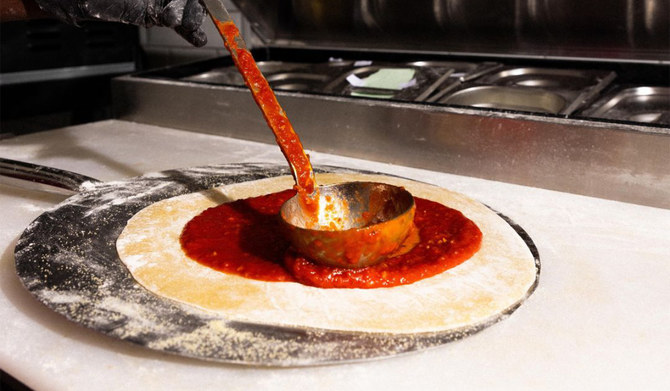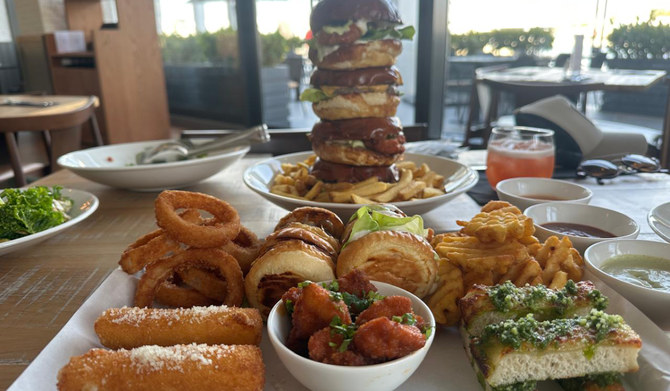
NEW YORK (DPA): Ice cream seems like a new invention, yet its history dates back millennia.
Even today, the concept of ice cream is still changing. Here are 12 things you should know if you want to become an ice cream aficionado.
Who invented ice cream?
Many imagine gelato originated in Italy but in fact, it comes from the Far East, according to three Italian historians.
People in China were eating iced fruit 4,000 years ago, historians say. They found a recipe for a cream made of cooked rice, milk and spices that was placed in the snow until it solidified.
In the Classical era, Greeks and Romans mixed snow and ice from the mountains with honey, fruit and rose water. Later, Britain’s King Richard I, also known as Richard the Lionheart, was served sorbet by Ottoman Sultan Saladin.
And the word sorbet comes from the Arabic sherbet and reflects its origins. Arabs were freezing fruit juice in tubs of crushed ice and saltpeter 2,000 years ago.
But the great step toward gelato as we know it today came in Florence in the 16th century, where confectioners added sugar, which was prohibitively expensive, then stirred the ice cream until it was creamy. This delighted French Queen Catherine de Medici so much that she brought the first ice cream makers to her court in Paris.

Then, in 1660, an Italian chef opened Procope, the city’s first coffee house. The celebrities of the day lapped up the establishment’s ice cream, made from cream, milk, egg and sugar, launching the world’s love affair with gelato.
Why do Italians dominate the world of ice cream?
Italians run many ice cream parlors in many places and dominate the market in much of Europe.
In many European countries, this dates back to the 1870s and 1880s, when the first ice cream makers from Italy came to the cities of Austria and Hungary. They started out selling ice cream from little carts that they pushed in parks and in front of schools.
Then, as tourism developed and people began to travel further for their vacations, northern Europeans fell in love with ice cream when they traveled to Italy. Inspired by the dolce vita, many returned home wanting to enjoy ice cream at home, just like on the Riviera and the Adriatic.
And many still keep going to their local Italian gelateria, even though there is strong competition from the U.S., and popular new products from Japan and Thailand.

The ice cream business is also a tough one, dependent on the seasons and the weather, and many Italian businesses were run by families, who pulled together, shared the profits and kept labor costs low.
What are the different types of ice cream called?
Ice cream, sorbet, parfait: There are lots of different names out there, and these are regulated in many countries, with the authorities stipulating what each contains, from the percentage of milk fat from cream in ice cream to the proportion of fruit in sorbet.
In the U.S., for example, ice cream must have no less than 10% dairy milk fat.
European Union rules, for example, say that a fruit sorbet must contain 25% of the fruit referred to in its name.
Parfaits, meanwhile, are ice cream made of cream and egg. Both ingredients are whipped separately, mixed with other ingredients and frozen.
Then there’s frozen yogurt, frozen custard, soft serve and sherbets, and here too the regulation of the ingredients varies by country.
Who eats the most ice cream worldwide?
New Zealanders eat the most ice cream, consuming just over 28 liters (7.4 gallons) a year. People in the United States eat nearly 21 liters per capita per year, and in third place come Australians, who eat some 18 liters every year.
Scandinavians are the biggest ice cream fans in Europe, with Finnish people eating an average of 14 liters per year, followed by the Swedes who eat 12 liters annually.
Frozen foods are a very dynamic business, however. When the weather is hot, cafes sell a great deal more than when it is cool.
In the recent hot summer of 2018, for example, ice cream consumption in Germany rose to 8.7 liters, up from 8 liters in a regular, more mixed summer. That may not sound like much, but it’s a good 114 scoops and almost twice as much as 50 years ago.
What is the most popular ice cream flavor?
In many countries, Britain and Germany included, vanilla ranks top as the public’s flavor of choice.
After vanilla and chocolate, Germans pick stracciatella, strawberry yogurt, pistachio and hazelnut, according to Uniteis, a union of Italian ice cream producers in Germany.
Those choices are fairly similar in Britain, according to one local newspaper. After vanilla, Brits opt for chocolate, then strawberry, mint chocolate chip, caramel or salted caramel, rum and raisin, then pistachio followed by raspberry, according to the Blackpool Gazette.
Reflecting on these choices, most ice cream fans are children, who have conservative tastes, says Annalisa Carnio, a Uniteis spokesperson.
While more experimental flavors are becoming available, such as mango-chili, Germany’s ice cream of the year 2021, often goes down less well, she says.
Germany has an ice cream of the year selected by Uniteis’ board of directors. Experts come up with two to three new recipes for the association’s members.
Some of the most unusual varieties, such as sweet potato or matcha cookies, are a popular a treat with young hipsters, says Beatrice Lewald-Barletta of the Barletta ice cream factory in Berlin, which supplies more than 150 cafes and bakeries throughout Germany.
She adds that there is a significant difference in terms of openness to new flavors according to generation and between urban and rural areas.
Many do try surprising flavors like garlic ice cream or red wine, Carnio says, but at the end of the day, most stick with what they know. “I always end up ordering stracciatella, too,” Carnio says.
Meanwhile, Giorgio Ballabeni, who runs two ice cream shops in Munich and supplies five others, says, “What’s better than vanilla? What’s better than chocolate? No one has found anything better. Basta!”
What other unusual flavors are people eating?
Experimental ice cream flavors also reflect where people are traveling, with pineapple and papaya swinging into fashion when Asian destinations opened up in the 1980s, Carnio says.
Other fashionable flavors that seem to be here to stay include tiramisu, latte macchiato, cookies and salted caramel.
Meanwhile, there are some classics with a slight tweak that have also endured, including chocolate combined with mint coconut and nougat, along with dark chocolate or white chocolate.

”My credo is: classic with an accent,” says Giorgio Ballabeni. He makes his Malaga ice cream with cayenne pepper, while he adds peppermint to fior di latte.
What’s the difference between mass-produced ice cream and homemade gelato?
The main differences between dairy ice creams are the ingredients, so whether the ice cream is made with fresh fruit, real milk or powder, as well as the amount of air stirred in.
Mass-produced ice cream often has 100% air markup, called overrun, says Stefano De Giglio, founder of ice cream brand Del Fiore. Overrun is the term for the percentage by which the ice cream has expanded due to air incorporated into the product during the freezing process, so 1 liter of ice cream mix would become 2 liters of ice cream.
That has two advantages for the industry, he says. “When I take it out of the freezer, I can portion it immediately with a spoon, it’s already creamy because the freezing point is delayed. That happens because of a lot of sugar and, most importantly, air.” Also, the air is free.
The downside of overrun, however, is that the ice cream has a less intense flavor compared to artisanal ice cream, which may have only 25% to 30% air added in and thereby a deeper flavor.
What’s new in the ice cream industry?
The largest ice cream makers on the market, such as Langnese and Scholler, started industrial production back in the 1930s. Today, Germany produces the most ice cream in the EU – ahead of Italy.
Supermarket bestsellers are the classic flavors, sold in liter tubs, though increasingly, ice cream makers are also selling 500-milliliter packs, particularly when it comes to new flavors or vegan versions, says Ernst Kammerinke of the German Confectionery Industry Association. After all, there are lots of single- or two-person households to cater to nowadays, he says, noting the liter-pack tends to be more popular among families.
Mixed multipacks are also becoming increasingly popular, containing four or six different kinds of ice cream. The industry also frequently teams up with well-known brands, leading to ice cream versions of chocolate bars or liqueur brands.
What goes into a premium ice cream?
The line between mass-produced ice cream and artisanal varieties is becoming increasingly blurred, and more and more premium brands are producing artisanal quality on an industrial scale for health food stores, supermarkets and ice cream parlors.
Stefano De Giglio, who founded Munich-base brand Del Fiore, imports his hazelnuts from Piedmont, pistachios and lemons from Sicily, mangos from India and Criollo chocolate and ginger from Peru. He gets his milk from Bavaria and all the ingredients are organic quality. Of course, that comes at a price. Customers pay around $7 for half a liter – but at least that only has 30% air.
He has a pro tip, too. If you’re preparing to eat artisanal ice cream, place the tub in the fridge for 15 to 20 minutes. Ice cream that contains relatively little air and sugar is harder to portion out, so that should make it easier. Don’t put it straight out at room temperature, though, as it would melt on the outside but the core would still be frozen solid.
What is the difference between gelato and U.S. ice cream?
While gelato makers work with whole milk, traditional ice cream in the U.S. contains a lot of cream. Although the regulations state 10% milk fat, 16% is not uncommon.
That means it contains twice as much fat as gelato – something Italians appreciate. American ice cream is Giorgio Ballabeni’s favorite, he says.
Italy itself does not have a single gelato tradition, De Giglio says. ”You find much sweeter ice cream in Sicily than in northern Italy.”
If you are a true blue fan of U.S. ice cream, then consider a trip to New York, where you can find the Museum of Ice Cream – with a photogenic ice cream portal, rainbow tunnel and pool of sprinkles. Plus, ice cream tastings from Californian producers are included.
How long does ice cream last?
If you store your ice cream at minus 18 degrees Celsius (minus 4 degrees Fahrenheit), you can keep it for several months. No worries if it thaws slightly either, says Harald Seitz, spokesperson for the Federal Centre for Nutrition.
Meanwhile, Stefano De Giglio has let his ice cream thaw and then refrozen it up to eight times without anything major happening. “It keeps quite well – if you don’t let it melt.”
Once the core of the ice cream gets warmer than minus 12 degrees Celsius, he says, ice crystals form over hours as it freezes, making the ice rough and less creamy. Worse still, germs and bacteria can enter the ice. That is one reason why you should never eat ice cream straight from the main tub, says Seitz.
Is ice cream healthy?
”Ice cream is for enjoyment, not to fill you up,” says Seitz. It has few healthy ingredients, while most types of ice cream contain a lot of sugar.
Ice cream also has more fat, usually at least 18% milk fat. Frozen yogurt has significantly fewer calories, says Seitz – as long as you don’t add a lot of chocolate on top.
On average, fruit ice cream contains 138 calories per 100 grams, while creamier ice cream such as vanilla or chocolate contains 200 calories.
The post All about ice cream: Origins, flavors, types appeared first on The Frontier Post.








